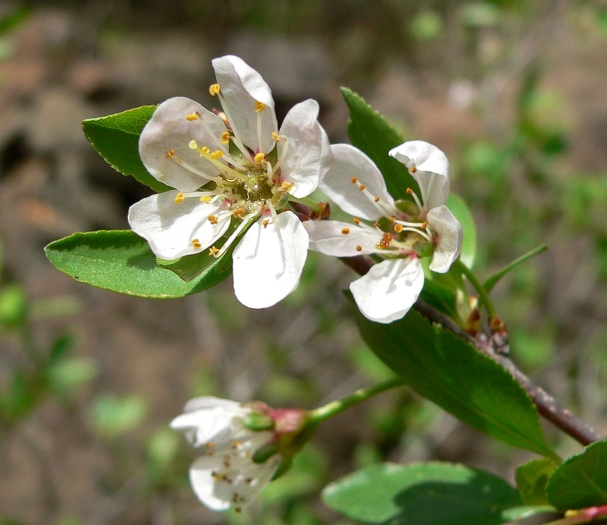Klamath Plum
(Prunus subcordata)
Klamath Plum (Prunus subcordata)
/
/

Stan Shebs
CC BY-SA 3.0
Image By:
Stan Shebs
Recorded By:
Copyright:
CC BY-SA 3.0
Copyright Notice:
Photo by: Stan Shebs | License Type: CC BY-SA 3.0 | License URL: https://creativecommons.org/licenses/by-sa/3.0 | Uploader: Stan Shebs | Publisher: Wikimedia Commons | Title: Prunus_subcordata_2.jpg | Notes: {{Information |Description= Shaving Brush tree trunk - looks a bit like like striped pajama material to me...Huntington Library Desert Garden May 2009 |Source=[http://www.flickr.com/photos/27398485@N08/3586733260/ Huntington Library Desert Garden May 2009 |





























Estimated Native Range
Summary
Prunus subcordata, commonly known as Klamath Plum, is a deciduous shrub or small tree native to chaparral and pine forests, as well as riparian zones in Northern California and Southern Oregon. It can reach up to 8 meters (26 feet) in height with a trunk diameter of up to 15 centimeters (6 inches). This species is known for its ability to sprout from its roots, often forming dense, spiny thickets. The bark is gray with horizontal brown lenticels, reminiscent of cultivated cherry trees. The white or pinkish flowers, about 2 cm across, appear in clusters of one to seven in the spring and are moderately showy. The fruit is a small, plum-like drupe, 15–25 mm in length, with variations in color from red to yellow, maturing in late summer. The plums are noted for their tart flavor.
Klamath Plum is valued for its wildlife benefits, as both the flowers and fruit provide food for various animals. It is also appreciated for its ornamental qualities, including its spring blossoms and the potential for creating natural barriers or hedges due to its thicket-forming habit. In cultivation, it is adaptable but prefers full sun to part shade, low water requirements, and well-drained soils. While not commonly found in cultivation, it can be used in native plant gardens, restoration projects, and for erosion control. Care should be taken when planting near walkways or high-traffic areas due to its spiny nature. There are no widely recognized cultivars of this species in the horticultural trade. Potential problems include susceptibility to pests and diseases common to Prunus species, such as aphids and fungal infections.CC BY-SA 4.0
Klamath Plum is valued for its wildlife benefits, as both the flowers and fruit provide food for various animals. It is also appreciated for its ornamental qualities, including its spring blossoms and the potential for creating natural barriers or hedges due to its thicket-forming habit. In cultivation, it is adaptable but prefers full sun to part shade, low water requirements, and well-drained soils. While not commonly found in cultivation, it can be used in native plant gardens, restoration projects, and for erosion control. Care should be taken when planting near walkways or high-traffic areas due to its spiny nature. There are no widely recognized cultivars of this species in the horticultural trade. Potential problems include susceptibility to pests and diseases common to Prunus species, such as aphids and fungal infections.CC BY-SA 4.0
Plant Description
- Plant Type: Shrub, Tree
- Height: 10-26 feet
- Width: 5-10 feet
- Growth Rate: Moderate
- Flower Color: White
- Flowering Season: Spring
- Leaf Retention: Deciduous
Growth Requirements
- Sun: Full Sun, Part Shade
- Water: Low
- Drainage: Fast
Common Uses
Bee Garden, Bird Garden, Butterfly Garden, Edible*Disclaimer: Easyscape's listed plant edibility is for informational use. Always verify the safety and proper identification of any plant before consumption., Fragrant, Low Maintenance, Rabbit Resistant
Natural Habitat
Native to chaparral, pine forests, and riparian zones in Northern California and Southern Oregon
Other Names
Common Names: Pacific Plum , Sierra Plum , Western Plum , Oregon Plum
Scientific Names: Prunus subcordata , Prunus subcordata var. subcordata
GBIF Accepted Name: Prunus subcordata Benth.